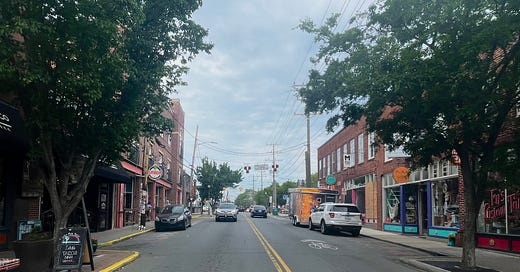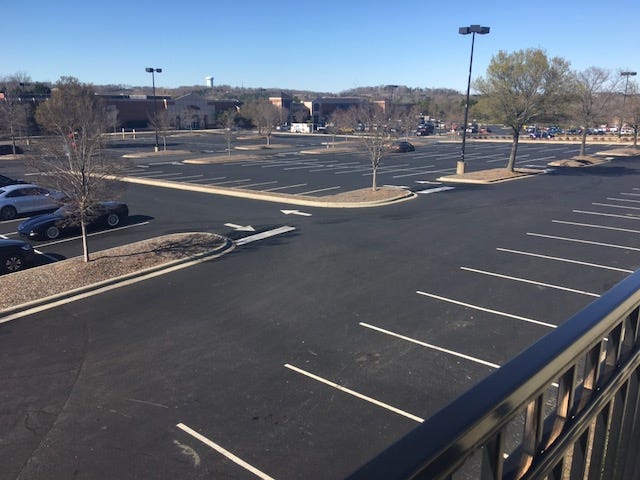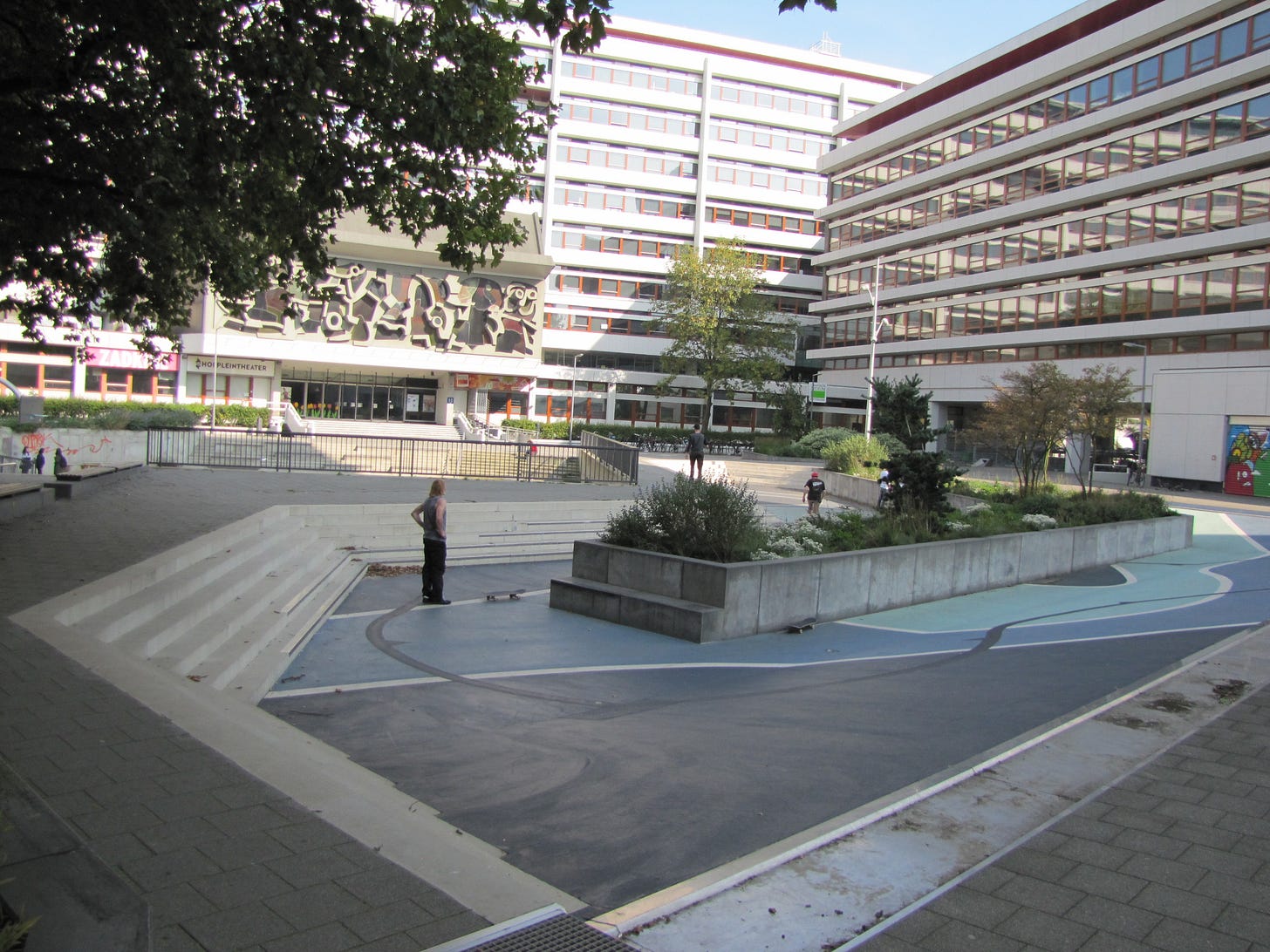An urbanist prescription for sprawling Charlotte
From street design to environmental features, there are ways to make cities more people-friendly
Support a thoughtful and independent source of local information by becoming a paid member of The Charlotte Ledger. Details here.
You’re reading Transit Time, a weekly newsletter for Charlotte people who leave the house. Cars, buses, light rail, bikes, scooters … if you use it to get around the city, we write about it. Transit Time is produced in partnership between The Charlotte Ledger and WFAE.
Column: A recent conference offered plenty of ideas for making cities more livable and sustainable. Can Charlotte put more of them into action?
The NoDa neighborhood generally gets high marks for its urban character, and North Davidson is a classic city street. The former mill village retains many older buildings while continuing to grow, integrating housing, light rail and commercial development. (Photo by Lindsey Banks/Charlotte Ledger)
By Mary Newsom
Streets, not stroads
Spongy, not crusty
Don’t fear the cave people
Huh, you might say? Read on.
Those slogans with odd words are a few prescriptions to make cities healthier, happier, and more sustainable — ideas Charlotte should get behind. They come from a recent Charlotte conference — the 31st annual Congress for the New Urbanism — which drew some 1,400 planners, activists, engineers and architects from around the U.S. and the world here two weeks ago.
In dozens of sessions, and over beer and wine at happy hours, they traded ideas for, and experiences with, undoing the mistakes of the past in cities like Charlotte: the scars of urban renewal and racial inequity, highways that carved through low-wealth neighborhoods, decades of sprawl and automobile-worship. You could hardly turn around without bumping into ideas for solutions — including some we should apply in Charlotte — from street designs to real estate strategies to wonky public policy changes.
Before getting to those odd words I opened with, let’s back up: Urbanists? Urbanism? New Urbanism? What are those, exactly?
Let’s start with “urbanism” and “urbanists.” Those are loosely applied terms. Urbanists are people who champion urbanism. Urbanism is, essentially, the quality of cities and towns acting like cities and towns, not exurbia: Homes and stores and offices are mixed together. Things are near other things. Buildings are close to the sidewalks and streets. New buildings mix with old ones. You can drive but also walk, bike or take mass transit. You know — the way cities and towns were built up until the middle of the 20th century.
Those qualities also bring efficiencies. They save land. They’re cheaper for municipalities to service and easier for mass transit to serve. Think of North Davidson Street in NoDa. Think of downtown Charleston. Think of Camden Road in South End.
New Urbanism is a movement that began in the 1980s to champion those qualities. Back then, planning, zoning and transportation engineering operated as if moving traffic trumped all other considerations, and that any residences other than single-family houses were somehow lesser. Suburban sprawl dominated. Zoning ordinances made it illegal to build new neighborhoods in the style of NoDa and downtown Charleston.
But in the 1980s and 1990s, some renegade architects, developers and planners decided to change things. They founded the Congress for the New Urbanism (CNU) in 1993. CNU — and plenty of other groups — have succeeded, in part. Today, most professional planning recognizes the importance of urbanism. Some real estate developers, and their lenders, are changing but at glacial speed. Others aren’t interested.
So, what did all these urbanists think of Charlotte? NoDa and South End were heavily visited and admired, in part because CNU organizers arranged for weekly transit passes for attendees, and those areas are an easy light rail trip. Tours highlighted places worth bragging about: Brightwalk and First Ward for affordable housing, Birkdale Village in Huntersville, greenways, the Rail Trail, etc.
Uptown was generally praised, though the convention center-Westin hotel area got dinged for unappealingly long blank walls and lots of concrete. For one outsider’s take, enjoy this wry look from attendee Ray Delahanty, who dubs his YouTube persona “CityNerd.” He says Charlotte “just might be the sprawl capital of Planet Earth.” But he also found much to like.
OK, what’s with “stroads” and sponges? And who are these cave people of whom you speak?
Those are catchy ways to describe some improvements Charlotte could be making — and here, “Charlotte” means city and county governments plus local activists, not simply Charlotte city government.
◼️ Streets not stroads. A “stroad” is a hybrid of a street and a road. Roads are about moving vehicles swiftly, from place to place, typically from one city to another. They usually have higher speeds, multiple lanes and infrequent stops. City streets are where commerce happens in stores or on sidewalks, where people encounter neighbors and strangers, where pedestrians and vehicles are equally valued. They value safety, not speed.
A stroad tries to do two things at once — be a road and a street — and does neither well. Charlotte is filled with them. Engineer and planner Chuck Marohn, founder of the nonprofit Strong Towns, coined the term in 2013. Stroads fail at moving people quickly from place to place and fail as city streets. Stroads, Marohn notes, “are enormously expensive to build and, ultimately, financially unproductive. They’re also very dangerous.”
The problem of stroads cropped up in many places, including one session highlighting an initiative to make the West Boulevard corridor work better for neighborhood residents. It’s a historically Black and underserved part of the city and a food desert lacking supermarkets. So residents and activists are working to launch a co-op grocery.
But while the west Charlotte vision plan showed a beautiful street with wide sidewalks and street trees, today’s West Boulevard remains a stroad. Its sidewalks are narrow and dangerous. It lacks pedestrian crossings. Traffic lights are far apart. Vehicles tend to ignore the 45 mph speed limit.
Can’t the city do better? Well, no, or at least not yet.
Like many Charlotte stroads, West Boulevard is state-owned and -maintained. It’s designed like a highway. That’s what the N.C. Department of Transportation does: They don’t build city streets. It took decades to even get NCDOT to agree to build sidewalks. West Boulevard is one of many state stroads in Charlotte, among them:
University City Boulevard, a multilane thoroughfare that thinks it’s a highway, not a street next to a 30,000-student university.
Johnston Road through Ballantyne.
Albemarle Road in east Charlotte.

Don’t hold your breath for NCDOT to tame its stroads, although I hope eventually staffing turnovers change the department’s outlook. A better option is for the city’s transportation department to take over West Boulevard and other state stroads that blight our city.
Charlotte street planners know how to tame ugly streets. West Boulevard becomes East Boulevard at Camden Road, and where it continues through Dilworth, no longer a state road, the city has installed medians, one-lane sections and other touches to make a city street a more pleasing place.
◼️ Spongy, not crusty. “Turn our crusty cities into spongy cities,” was advice from Hazel Borys of Winnipeg, Canada, managing director of the Placemakers design firm. Not crusty, as in lovably grouchy old uncles, but covered with pavement. Spongy, as in, places where rainwater is absorbed into the ground rather than flooding low-lying streets and businesses and polluting our creeks.
The Mallard Pointe shopping center on North Tryon Street across from UNC Charlotte is, like most strip centers, heavily “crusty,” or covered with pavement. (2018 photo by Mary Newsom)
With climate change, we’ll keep seeing heavier and more intense rains. Meanwhile, new developments create more crust — rooftops, streets, sidewalks and ever more parking lots. Between 2011-2021, 13,539 acres of land in Mecklenburg County were covered by impervious surfaces. That’s the size of Matthews and Pineville combined.
Borys emphasized the need to transition away from the old practice to pave, pipe and dump the water, and begin treating rainwater near where it falls.
Charlotte, especially Mecklenburg County government, continues working to clean up and naturalize our many creeks and to help development retreat from floodplains. But Borys offered some creative ideas, many with the advantage of being nice to look at — not just large, suburban-style detention ponds that often end up poorly maintained by cash-strapped HOAs.
One idea she pitched could easily happen here: “water squares” or “pond parks.” Think retention pond, but built to be a plaza or a park most of the time, with low-lying areas deliberately designed to store or absorb runoff during heavy rains.
This “water square” in Rotterdam, the Netherlands, functions as a public space as well as a site for stormwater storage during periods of heavy rain. (Cathrotterdam / Creative Commons)
Borys and her colleagues offer a Green Infrastructure Toolkit showing how to formally protect wetlands, build rain gardens in street medians and design green streets with more trees and water squares.
◼️ Beware the CAVE people: In a closing address, Greensboro City Manager Taiwo Jaiyeoba, formerly Charlotte’s assistant city manager and planning director, gave a pep talk, encouraging the assembled urbanists to “go out and make change in an uncomfortable world.”
As he and his audience knew, change is slow, and retrofitting is tough. But he urged perseverance.
Start thinking of affordable living, instead of just affordable housing, he suggested. Make sure regulations don’t stifle creativity. And he warned against being stymied by CAVE people — Citizens Against Virtually Everything.
Good advice for elected officials here, who sometimes seem to value residents who oppose stuff — affordable housing, duplexes here and there, or anything that might slow their drive to the Teeter — above their professionally paid advisers, a.k.a staff.
And he quoted urban thinker and activist Jane Jacobs: “The point of cities is multiplicity of choice.”
Amen.
Mary Newsom is a freelance writer in Charlotte. She is retired from the UNC Charlotte Urban Institute after working decades at The Charlotte Observer. She specializes in writing about cities, especially Charlotte.
In brief…
CATS naming rights contract: The City Council on Monday approved a contract between the Charlotte Area Transit System and Innovative Partnerships Group to land “corporate sponsorship and naming rights” for certain CATS assets. The city has previously said it would like to sell naming rights to the new Charlotte Transportation Center and the surrounding area.
Blue Line gets thumbs-up from planner: An urban planner who visited Charlotte from Los Angeles and stayed at a hotel near Woodlawn Road writes that he was impressed: “Wow, was I pleasantly surprised with Charlotte’s light-rail system. For years I have worked on advocating, planning, and riding L.A.’s light-rail lines. Compared with our city, Charlotte is next level in planning, design and execution.” (Common Edge)
Train maintenance expansion under scrutiny: Plans by the N.C. Department of Transportation to expand an Amtrak maintenance complex in South End are raising eyebrows because of the potential effect on future development and on the Wilmore neighborhood. (Charlotte Business Journal, subscriber-only)
Readers weigh in on Providence Road: In a totally unscientific poll of Transit Time readers last week, a majority said they supported widening Providence Road. Of 393 respondents, 57% said it should be widened, 30% said it should not, 9% said they needed more information and 5% said “who cares?” We reported that the N.C. Department of Transportation is in the early stages of examining the possibility of widening Providence and adding turn lanes to several busy intersections.
Transit Time is a production of The Charlotte Ledger and WFAE. You can adjust your newsletter preferences on the ‘My Account’ page.
Did somebody forward you this newsletter and you need to sign up? You can do that here:
Other affiliated Charlotte newsletters and podcasts that might interest you:
The Charlotte Ledger Business Newsletter, Ways of Life newsletter (obituaries) and Fútbol Friday (Charlotte FC), available from The Charlotte Ledger.
The Inside Politics newsletter, available from WFAE.








Happy to have found Mary Newsome again!!
Mallard Point is going to be completely redesigned into a walkable, dense, college “Main Street”. This should be mentioned in the caption. Not everything in UC is as bad as people make it out to be.